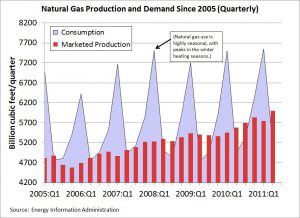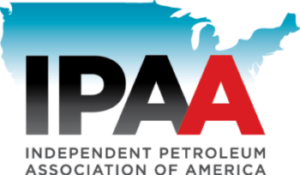Sep 19, 2011 Defining Natural Gas in America – Record Breaking vs. Bridge Building
In the midst of a nationwide debate about the need for jobs, economic and government revenues, and increased energy security, we must look to our nation’s energy potential for answers. The outlook for natural gas should not be underestimated. In 2011, the U.S. may post records in production and consumption of natural gas. It is strikingly clear that this fuel will be a primary part of our energy supply mix for decades to come.
Growing Supply: What was once truly “unconventional” has now become a primary supply source. The latest Potential Gas Committee (PGC) study recently increased the technically recoverable reserve base for our country to 1,898,000 billion cubic feet – the highest the PGC has ever published in its 46 year history. The nation has reserves that yield over a century of secure American natural gas supply. Producing natural gas wells set a record in 2009 according to the Energy Information Administration (EIA). Monthly production records have already been made in May and June and this record-setting looks to continue on an annualized basis. The rising supply of natural gas has allowed our nation to markedly reduce the level of imports as production rises to cover a larger share of American demand.
Rising Consumption: The share of natural gas consumption in the U.S. energy matrix has grown from 22.3 percent in 2006 to almost 29 percent so far in 2011. Over the past five years, industries ranging from utilities to natural gas vehicles are significantly increasing their demand for natural gas.
America’s independent producers have engineered the technological “shot heard round the world” through their utilization of horizontal drilling combined with hydraulic fracturing that enabled the shale gas revolution. Their efforts have equated to a full-scale sea change in demonstrating America’s bountiful natural gas resource potential as well as its growing production profile. Other countries are doing their own shale-searching as a result of America’s pioneering accomplishments.

Unfortunately, the bright future of natural gas is not without threats. Although natural gas is a green-friendly fuel, environmental groups resist natural gas development through their manic opposition to hydraulic fracturing, the process integral to unlocking natural gas. These groups claim that hydraulic fracturing has the potential to contaminate drinking water, although the process has been utilized by the industry for decades with no proven case of contamination and well over one million wells drilled. Energy in Depth, the industry coalition led and managed by IPAA, has led the proactive campaign to dispel myths propagated by these groups and promote the industry’s proven safety record on hydraulic fracturing.
The Obama administration, despite claiming to be supportive of natural gas development, has regrettably given credence to the outlandish claims of environmental groups. For instance, the Department of Interior has sought to ban horizontal drilling associated with hydraulic fracturing on federal lands such as the George Washington Forest. Earlier this summer, Lee Fuller, IPAA’s Vice President of Government Relations testified before the House Natural Resources and Agriculture Committees, and argued that that the proposed ban “presents a far larger issue – the reluctance of the current Administration to support the development of the full spectrum of American resources.”
The Environmental Protection Agency (EPA) in has sought to inhibit the development of natural gas through the guise of regulating hydraulic fracturing. First of all, the EPA wants to regulate hydraulic fracturing using an ill-conceived interpretation of the Safe Drinking Water Act (SDWA). Also, the Fish and Wildlife Service (FWS) proposed that the dunes sagebrush lizard be added to the Endangered Species List, which would halt all drilling where the three-inch lizard resides in the heart of Texas’ Permian Basin.
Last month, the Department of Energy’s Secretary of Energy Advisory Board (SEAB) Natural Gas Subcommittee released a report on hydraulic fracturing which correctly stated that there was minimal evidence of drinking water contamination, but recommended stronger regulation. IPAA urged the administration to give credence to the successful state regulatory regimes already in place. In particular, IPAA has worked to promote FracFocus.org, an online registry run by jointly by state regulators and industry actors which improves public information about shale gas operations.
IPAA has been tirelessly working in Washington to ensure that natural gas’ bright future is not blighted by regulatory threats from federal bureaucrats and hostile anti-industry groups that fail to see the importance of natural gas as a strategic fuel for American prosperity and security. American natural gas production creates U.S. jobs, revenues, energy security and even reduces our carbon signatures. Rather than being perceived as a bridge fuel it is more important for politicians and consumers to cross the bridge of realization that this strategic fuel represents one of the foremost success stories of the past decade.








